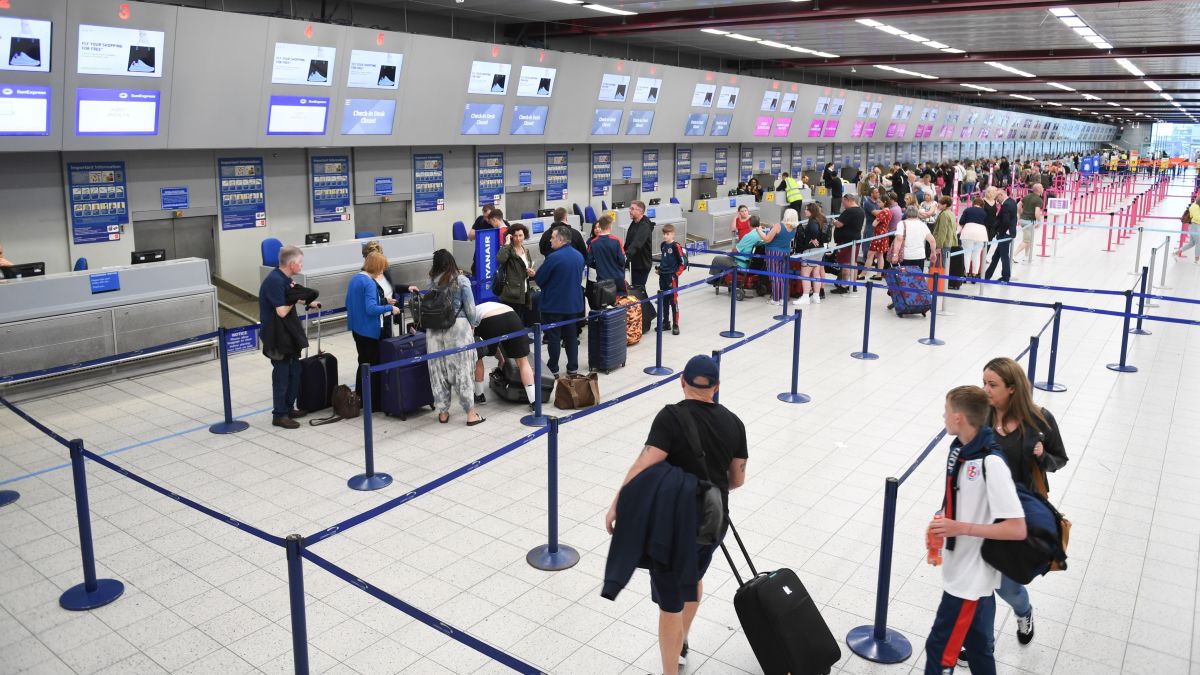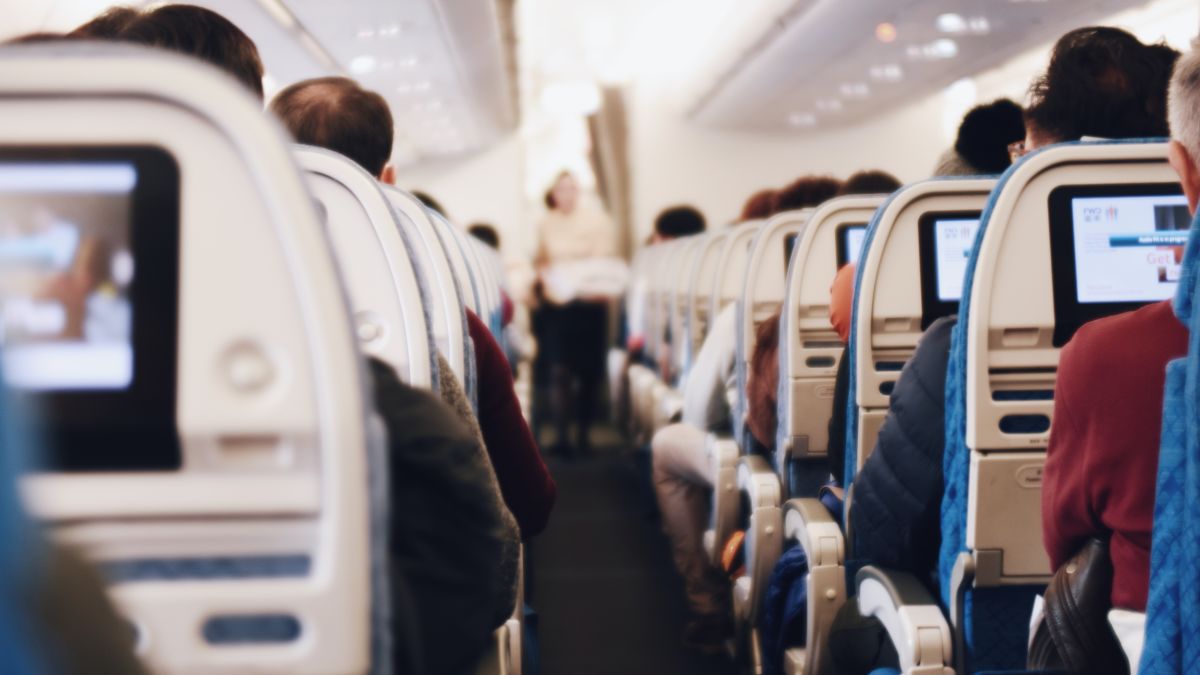Air Travel

Most pregnant women can travel via aircraft with no need for major considerations. In healthy, non-term pregnancies, women do not experience any additional risks associated with air travel, especially flights under four hours long.
However, for women with various risk factors or underlying conditions, there are factors to consider, such as increased immobilization (deep vein thrombosis), oxygen desaturation, risk of spontaneous and preterm labor, and general discomfort. These factors can be prevented/mitigated with proper planning and discussion with an HCP.
Although evidence is limited, there is currently no evidence air travel in the first trimester causes miscarriage, to include research conducted on flight attendants. Cosmic radiation is also considered very minimal, especially in the occasional traveler.
Before traveling, pregnant women should always visit their airline carrier’s website to read information on their pregnant-traveler policies, and get medically cleared from their HCP to fly, especially depending on week of gestation.
Background
Healthy women, with non-term, healthy pregnancies and no underlying conditions, generally do not experience increased risks for complications when traveling on an airplane.
However, air travel is often a concern during pregnancy, mostly because airlines/aircraft crew are not equipped to handle an obstetric emergency in the air. Further, lengthy flights (over four hours) can start to increase the risks of complications that can occur afterward.
Concerns are often raised regarding deep vein thrombosis, swelling, preterm labor, miscarriage, unexpected bleeding, oxygen levels, general discomfort, and radiation from cosmic rays and airport scanners.
Pregnant women who are traveling, especially later in pregnancy, need to check their airline’s website for their pregnant-flier policies, and talk to their HCP regarding any medical risk factors they need to consider before traveling.

Concerns/Considerations
Traveling after 36 weeks increases the risk of spontaneous labor while in the air; women at risk for preterm delivery may need to stop flying well before this time.
Deep vein thrombosis (DVT) and swelling: DVT is a rare condition in which a blood clot forms deep in a leg. There is an increased risk of DVT for some women, related to the immobility of lengthier flights, usually four hours or longer; however, there are many preventative techniques women can take (see Action) to reduce this risk.
General discomfort: Nasal congestion, dehydration, and frequent urination are all items women should consider when traveling. Cabin pressure, along with increasing altitude, can hurt the ears, which could hurt worse than usual if nasal/ear congestion is already present due to pregnancy-related changes.
Dehydration can also occur in the drier cabin air (debated), therefore, it is often recommended women stay hydrated. However, this can worsen frequent urination, but frequent trips may help keep the legs mobile.

Nausea: Some women who experience motion sickness may experience nausea during air travel, while others traveling in the first trimester may find it very difficult if suffering with nausea and vomiting of pregnancy ( NVP ) as well (Read Traveling with NVP ).
Unexpected bleeding: Vaginal bleeding can occur at any point during pregnancy. Although bleeding could coincidentally occur during air travel, there is no evidence air travel causes miscarriage or other complications that could lead to bleeding. However, women with placenta previa or other placental issues, or those at risk for placental concerns should not travel, as catastrophic bleeding could occur, which may lead to devastating consequences on an airplane.
Women should also have their HCP confirm a viable intrauterine pregnancy prior to traveling in the first trimester. It is possible an ectopic pregnancy could cause extreme pain/rupture during a flight, which could be life-threatening.
Note: Although evidence does not indicate an increased miscarriage risk, evidence is also very limited and fraught with methodological errors. It is important to note that miscarriage, as well as air travel during the first trimester, are both common. It is very difficult to determine any cause of miscarriage, let alone whether air travel played a role.
Several studies have found no additional miscarriage risk in flight attendants; although one particular study found a modest increased risk of miscarriage, this was assessed to be related to many aspects of a flight attendant’s job, to include cosmic radiation, physical demand, and circadian rhythm disruption.
Altitude
Although cabins are pressurized, this still equates to a comparable altitude between 4,000 and 8,000 feet at cruising altitude. Barometric pressure is significantly lower than at sea level and usually results in a reduction in the partial pressure of oxygen, in turn leading to a reduction in blood oxygen saturation (SpO2) of about 10%.
One study examined the oxygen saturation levels of healthy airline passengers and found more than half of the travelers had SpO2 values less than 95% at cruising altitude, with a range of values between 85% to 98%.

Fortunately, this type of reduction is not a problem for healthy individuals or healthy pregnancies. Pregnancy-related blood volume changes include an increase in red cell mass, which provides greater oxygen to the fetus. This increase helps compensate for any decrease in the mother’s oxygen saturation during air travel.
However, oxygen saturation may get lower as flight length increases. Further, pregnant women with anemia, heart disease, asthma, or other pulmonary issues may experience greater degrees of desaturation. Women should always talk to their HCP prior to air travel, especially with long-haul flights, and/or the existence of underlying conditions, as some women may need supplemental oxygen during necessary travel.
Cosmic Radiation
Air travel does expose individuals to additional radiation compared to everyday environmental exposure on the ground.
Galactic cosmic rays (a type of cosmic ray) are a “highly energetic background source of energetic particles” traveling at large fractions of the speed of light with tremendous energy. When these particles hit the atmosphere, large showers of secondary particles are created, and some may even reach the ground. These rays are fully ionized, meaning they expose individuals to radiation which increases with increasing altitude. At airliner flight altitudes, exposure rates become several hundred times greater than at sea level.

For most pregnant air travelers, risks to the fetus from exposure to cosmic radiation is considered negligible. For example, any particular individual has a higher risk of developing cancer by chance than developing cancer from cosmic radiation exposure. Additionally, because individuals are constantly exposed to this type of radiation even without air travel, air travel does not significantly increase the risk of harm.
The current maximum annual exposure limit is 1 Millisievert (mSv) of radiation for members of the general public – to include pregnant women – and 5 mSv for pregnant flight crew. Even the longest available intercontinental flights will expose passengers to no more than 15% of this 1 mSv limit. To receive 1 mSv exposure during air travel, it is estimated an individual would have to fly approximately 75,000 miles (121,000 km). This equates to about 15 roundtrips between New York and Los Angeles (within one year).
An important distinction to make, especially for women who travel further than 75,000 miles in one year, is that 1 mSv is not the minimum amount in which damage may begin to occur, but only a safety limit set by various U.S. regulatory agencies. A complex calculation by the U.S. Federal Aviation Administration (FAA) shows the probability for fetal damage to be about 3 in 10,000 for a 1 mSv total exposure.
This is also because direct fetal exposure is much lower. The current estimated fetal dose during a transatlantic flight is 0.01 mSv. For comparison, naturally occurring background radiation during pregnancy is 1 mSv.
Current statistics show that about 600 of every 10,000 children are born with abnormalities that have serious health consequences. It is estimated that exposure to the maximum permissible dose of 1 mSv could increase the number of birth defects from 600 to 603.
Energetic solar flares are an additional factor influencing inflight radiation exposure at an estimated 10 to 20 times normal values. However, although about 10,000 solar flares are detected each year, only about 20 are considered powerful enough to affect air travel.
Airport Scanners and Radiation
Luggage screening is safe, to include the operation of the machines by a pregnant technician. The design of the machine itself, casing, and lead curtains at each entry/exit prevent radiation from escaping.
There are two kinds of body scanners used in U.S airports: millimeter-wave scanners (no radiation) and backscatter x-ray scanners (radiation). Pregnant travelers can, at any point, request a body search/pat down by a female Transportation Security Administration (TSA) employee instead of walking through a backscatter scanner.
Millimeter-wave (MMW) systems emit low energy, non-ionizing radio frequency waves (think microwave and wireless/cell phone emissions) which is not radiation. These systems deliver energy estimated to be 10,000 times less than a cell phone.
Although research is limited, current evidence does not confirm the existence of any health consequences from exposure to low level electromagnetic fields. (Read more information related to pregnancy and laptops, tablets, and cell phones.)
In 2008, the TSA introduced backscatter x-ray systems for airport security; these systems are often met with health concerns due to radiation exposure. In November 2011, the European Commission announced no backscatter systems would be used in European Union airports, only MMW systems due to these health concerns. Although some U.S. airports still use backscatter systems, TSA has begun deploying MMW systems more often.
The energy of the x-ray beam does not penetrate the skin and just makes a picture of the outline of the external torso, with almost no penetration to the internal organs; risks of radiation exposure to these machines has been described as “extremely low” and “truly trivial".
Backscatter systems create an image from very small amounts of x-ray that reflect off the person being screened, not through (such as medical x-rays). Exposure is estimated at 5 millionths (0.000005) of a rem. For comparison: 1 mSv, the maximum exposure recommended per year, equals 0.1 rems. It has also been estimated that backscatter machines produce radiation exposure equivalent to two minutes of air travel and that 1,000 scans would be required to match the exposure of one chest x-ray.
Action
Pregnant women at risk for preterm labor, vaginal bleeding, placental disorders, or venous thrombolytic events, or have underlying respiratory or cardiac conditions, or are 36 weeks of pregnant or more, may be advised not to fly. Pregnant women considering traveling via aircraft during pregnancy should always talk to their HCP first.
Women should pack their prenatal records as well as their HCP's contact information. Women may also need a note from their HCP regarding their estimated due date, and possibly even a medical clearance to fly (depending on airline policy and week of gestation).
Pregnant women should also talk to their HCP if they are conducting international travel; for some at risk areas, vaccinations may be necessary.
For comfort and convenience, women should remember to pack all items they may need during the flight in their carry-on bag. This could include prescription medications, hemorrhoid cream (for long flights), antiemetics (nausea), antacids, and pantyliners (for leaking); women should also wear loose clothing and comfortable shoes in case of bloating and/or swelling.
Women should also have snacks and water in their carry on, and should consider a travel pillow for additional comfort.
During travel:
Pregnant women should always wear a seat belt while on an airplane. The lap portion should be under the abdomen and over the upper thighs.
To minimize the risk of DVT, especially following long-distance flights, women should wear compression garments that can be worn comfortably under clothing. Women should also move their legs as much as possible which includes walking or standing (when permitted/safe), and remain hydrated throughout the flight.

Women should stretch their arms above their heads, take deep breaths, lift up their legs, and stretch as much as possible. Women should also consider setting a timer on their phone for every 20 to 30 minutes (depending on flight time) to remind them to flex their ankles and calves and stretch their legs, even while seated.
Resources
Air Travel and Pregnancy (Royal College of Obstetricians and Gynaecologists; January 2015)
Pregnancy and Flying (The International Federation of Air Line Pilots’ Associations)
Air Travel and Pregnancy: Scientific Impact Paper No. 1 (Royal College of Obstetricians and Gynaecologists/Aerospace Medical Association; May 2013)
Air Travel and Pregnancy: Committee Opinion 746 (American College of Obstetricians and Gynecologists)
Aircrews and Ionizing Radiation (The International Federation of Air Line Pilots’ Associations)